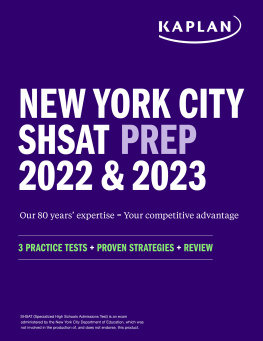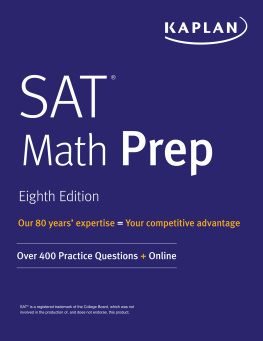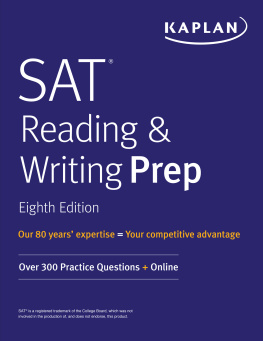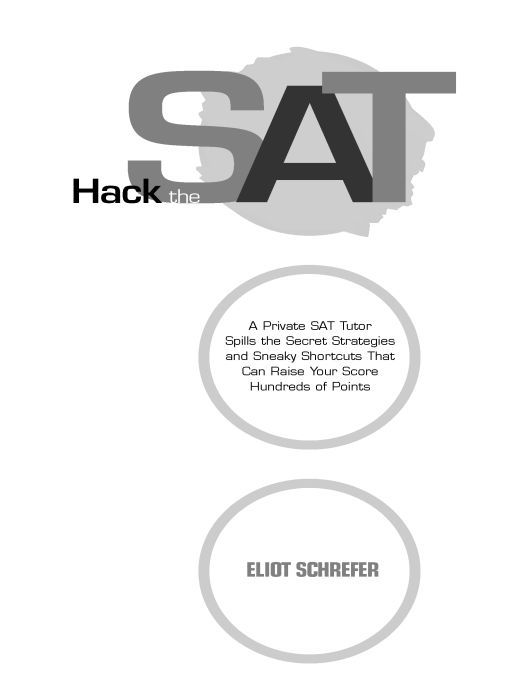Table of Contents
How to Ace the Most Infamous Test inthe World, with Straight Talk from aFlorida Public School Kid Who Got intoHarvard and Personally Tutored theAmerican Aristocracy
GOTHAM BOOKS
For my students, past and present:
Alex, Alexa, Alyssa, Amanda, Amanda, Anais, Anand, Annie, Annie, Ashley, Barry, Ben, Cammy, Caroline, Casey, Claire, Colin, Cosima, Dan, Daniela, David, Dominica, Ed, Eleanor, Eli, Emily, Emma, Erica, Erik, Grace, Hannah, Insia, Isar, Jackie, Jadry, Jen, Jenny, Jeremy, Jessica, Jessica, Jordan, Josh, Josh, Julia, Kate, Kate, Kelsey, Kim, Krysia, Labe, Laura, Lianna, Lindsay, Liz, Luke, Manny, Marina, Marissa, Mark, Marshall, Michael, Michelle, Moishe, Morgan, Nell, Nicholas, Nicole, Nicole, Rachel, Rachel, Rachel, Rachele, Rebecca, Ricky, Robby, Russell, Sam, Sam, Samantha, Schuyler, Scott, Shara, Shira, Sophie, Spencer, Stuart, Susan, Suzi, Sydney, Tassilo, Tory, Valentina, William, Zach, and Zach.
INTRODUCTION
Stop Studying SO Hard, Dum-Dum
Crack open the giant SAT guides, and it seems like theres a mountain of info to learn. And there would be tons to coverif you hadnt already been going to school for twelve years.
The truth is that the SAT isnt all that overwhelming a test. Theres no math on it that you havent covered in class long ago; the essay is shorter and more forgiving than that of your average final exam; the grammar is just a formalization of language rules you use every time you speak; and the reading passages, while often deadeningly boring, dont require any outside knowledge.
The trick is to adapt what you already know to the test. As far as actual technical learning, you already know it all. Just as youve always suspected!
Which isnt to say that you dont still need help.
A few years back some hypercompetitive Manhattan parent realized he could make other kids eat his Suzies dust by getting her expert help. And so was born the very first private SAT tutor, succeeded through the years by a tight group of brainy Ivy League grads, who carefully cultivated the rules and strategies that would help their students typically gain 375 points or more over a year of tutoring.
Tutoring works, with average results far beyond those of a Princeton Review class. We tutors scored in the top percentile, know exactly what it takes to nail the test, and how best to present it.
If getting into college is supposed to be a fair process, then everyone should have access to our little-known strategies. But they dont: the average score among those whose families are in the highest income bracket is 30 percent higher than that of those whose families are in the lowest.
These tricks that have so inflated the scores of those in the know, that cost $40,000 for the year of preparation, have been kept under lock and key. Until now.
Want the same score increases? Read this book.
Who the Hell Is This Schrefer Guy?
Let me introduce you to your new best friend. Me.
I attended a large public high school that had cinderblocks slathered in peach-colored paint, a revered football team, and a population of malcontents that included a small but influential population of nerds. I was one of those nerds, passionately and fully.
We were aware private school kids existed, somewhere, though none of us had ever met any. We figured a cloud of weird feeling would settle over us as soon as we met some. They would be sorta normal, but over-pronounce their Rs. Theyd discuss Socrates over (virgin) martinis and maybe have eyes that bugged a little. The guys would wear knotted cardigans and the girls plaid skirts held together with big safety pins.
Well, I ended up going to Harvard, which was full of em. My private school friends didnt talk funny (or any funnier than Harvard students generally speakI swear I heard the word ubiquitous daily), or wear plaid skirts unless they were going to a theme party or they were that one girl who wore pearls every day. No, the only thing that made private school kids different was the very fact that they had been to private schools.
Then in 2001 I graduated and landed in New York City (after a great year-long side trip to Rome), trying to make it as a writer and struggling to pay for my milk and bananas and Harlem rent. Like anyone really desperate for cash, I fell back on my best asset. For some people, twenty-two and new to the big city, that means stripping. But my buns arent so hot; my SAT score was awesome, though, so I started working as a private SAT tutor.
I loved it. The students were generally charming and focused, and those who werent were all the more interesting. And they all were glad to have a teacher to hang with who talked to them like an equal.
The pay was also pretty darn good. Manhattan tutor rates climb as high as $1,000 an hour. And for what? Access to a set of rules and tips that have been bumping up the scores of Americas wealthy for a couple of decades now.
Whether youre in private school or public, whether you live in a yacht with a swimming pool or a trailer with a cesspool, these are the rules youre looking for. Lets crack this nut wide open.
PART I
NINE EPISODES FROM YOUR JUNIOR YEAR
(Basics of What Youll Be Facing)
EPISODE 1
You First Hear About the Test
(OR You Experience a Bout
of Lunchroom Terror)
Youre not arriving at the SAT as a blank slate. Perhaps its because you have an older brother who never got into the University of Guam because of it. Perhaps its because your parents yak about the test, saying that no one ever
prepared back in the day, the worlds just gotten so crazy. Perhaps its because the first day of high school you sat with the juniors by mistake and got an earful of their stress before they inserted you into a trash can. Whatever the cause, you have a whole host of preconceptions. Some are probably right, and some are probably wrong. Lets find out the basics of what were dealing with before we go any further.
1. The SAT is a three-hour-and-forty-five-minute exam that starts at 8:30 A.M. on a Saturday morning. Once you add in the breaks and set-up it will most likely be 1:30 P.M. by the time youre sitting down to your reward lunch.
2. It has ten sections: three each for Math, Critical Reading, and Writing, and one extra experimental section in (randomly) one of the three.
3. The test is offered seven times a year in the United States: October, November, December, January, March/April (varying), May, and June. If youre taking the test abroad, check out www.collegeboard.org. You might have fewer available test dates.
4. Scores are out of 2400, 800 for each of Math, Critical Reading, and Writing. Each section is scaled so that 500 is roughly average.








![ACT - The official ACT prep guide, [2018]: [the only official Prep Guide from the Makers of the ACT]](/uploads/posts/book/164684/thumbs/act-the-official-act-prep-guide-2018-the.jpg)
![Steven W. Dulan - ACT Cross-Platform Prep Course [2017]](/uploads/posts/book/88504/thumbs/steven-w-dulan-act-cross-platform-prep-course.jpg)




